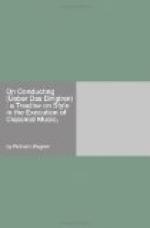[Figure: musical example]
the notes of which we believed to sound softly legato; the tenderly whispering
[Figure: musical example]
touched us as with wings of angels, and before the solemn admonitions and questionings of
[Figure: musical example]
(which, however, we heard in a finely sustained crescendo) we imagined ourselves led to a blissful evanescence, which came upon us with the final bars. Fancies of this sort, however, were not permitted during the “strictly classical” performance, under the veteran Capellmeister, at the Munich Odeon; the proceedings, there, were carried on with a degree of solemnity, enough to make one’s flesh creep, with a sensation akin to a foretaste of eternal perdition.
The lightly floating Andante was converted into a ponderous Largo; not the hundredth part of the weight of a single quaver was spared us; stiff and ghastly, like a bronze pigtail, the battuta of this Andante was swung over our heads; even the feathers on the angel’s wings were turned into corkscrew curls— rigid, like those of the seven year’s war. Already, I felt myself placed under the staff of a Prussian recruiting officer, A.D. 1740, and longed to be bought off—but! who can guess my terror, when the veteran turned back the pages, and recommenced his Largo—Andante, merely to do “classical” justice to the two little dots before the double bar in the score! I looked about me for help and succour—and beheld another wondrous thing: the audience listened patiently: quite convinced that everything was in the best possible order, and that they were having a true Mozartian “feast for the ears” in all innocence and safety.—This being so, I acquiesced, and bowed my head in silence.
Once, however, a little later on, my patience failed. At a rehearsal of “Tannhauser” I had quietly allowed a good deal to pass by unnoticed—even the clerical tempo at which my knights had to march up in the second act. But now it became evident that the undoubtedly “veteran” master could not even make out how 4/4 time was to be changed to an equivalent 6/4: i.e., two crotchets
[Figure: two crotchets (quarter notes)]
into a triplet of three crotchets
[Figure: a triplet of three crotchets (quarter notes)]
The trouble arose during Tannhauser’s narrative
of his pilgrimage
(Act III.), when 4/4
[Figure: musical score example]
is replaced by 6/4
This was too much for the veteran. He was very properly accustomed to beat 4/4 on the square; but it is also the custom of such conductors to beat 6/4 after the manner of 6/8, that is, with an Alla breve beat—two in the bar. (Only in the Andante of the G minor symphony did I witness six grave quaver beats = 1, 2, 3,—4, 5, 6). But, for my poor narrative about the Pope at Rome, the conductor thought two timid Alla breve beats sufficient—so that the members of the orchestra might be left at liberty to make out the crotchets as best they could. Thus it came to pass that the tempo was taken at exactly double the proper pace: namely, instead of the equivalents just described, things appeared thus:




